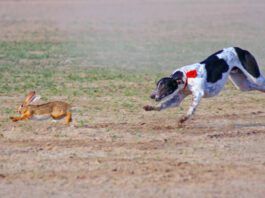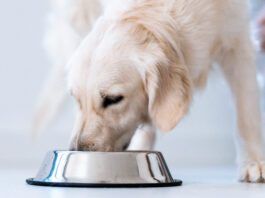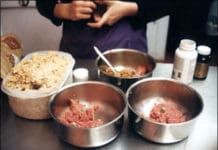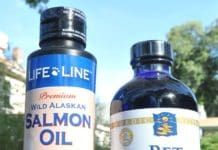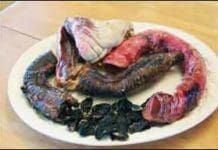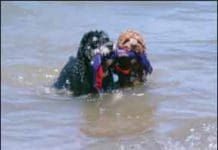Homemade Dog Food Ingredients: 3 Essential Foods for Dogs
Whole Dog Journal steers away from providing dog guardians with step-by-step recipes for dog food, raw or cooked. We can share expert dog companions' personal protocols for feeding their dogs home-prepared, but quickly you will realize not only that the perfect dog food recipe does not exist, but that in order for your dog to receive all necessary nutrients, you really need many recipes that include many different whole food ingredients.
Raw Dog Food and Salmonella Risks
Thanks to dogs' industrial-strength digestive systems, their strong stomach acids usually disarm the Salmonella bacteria before they can cause illness. And even if enough of the bacteria survive and manage to take up residence in the dog's digestive tract, he may well be completely asymptomatic; not all canine carriers of Salmonella become ill. This makes it difficult to know how widespread Salmonella infections are in the canine population.
The State of the Commercial Raw Diet Industry
Three of the most knowledgeable and experienced advocates of well-formulated raw diets for dogs have joined forces to explain how to evaluate commercial raw diets. We described them in the inaugural installment of this column last month: Dr. Karen Becker, a leading holistic veterinarian; Steve Brown, one of the founders of this industry; and Mary Straus, one of the most dedicated canine nutrition researchers and writers. This month, we've asked them to address the state of the commercial raw diet industry, starting with diets that are labeled as complete and balanced" or "AAFCO-compliant" (formulated to meet the nutritional levels established by the Association of American Feed Control Officials).Their executive summary? More and more dog owners and veterinarians are learning that well-formulated raw diets are the best food for most dogs most of the time but the commercial raw dog food industry has problems. They are disappointed with the apparent lack of basic nutritional knowledge demonstrated by many companies as evidenced by the formulation of their products despite the manufacturers' good intentions.They hasten to add
High Pressure Processing in Raw Dog Food
Were you aware that, according to Federal law, it's okay for a certain percentage of the chicken you buy in the supermarket to contain some Salmonella bacteria? The legally acceptable amount depends on the kind of chicken we're talking about; if we're talking about whole raw broiler chickens, up to 9.8 percent could be infected, but if we're considering raw chicken parts, the number is even higher. In fact, up to 15.4 percent of the raw chicken parts may contain that pathogenic bacteria, without setting off any sort of recall or hysteria. In contrast, even a single positive test for Salmonella in raw dog food triggers a recall and headlines and a certain amount of hysteria among dog owners. What gives?
New Challenges for Commercial Raw & Frozen Food Producers
People who believe in the value of feeding their dogs a biologically appropriate diet, comprised largely of raw meat and bones – with other foods added only to ensure that all their nutritional needs have been met, not as lower-cost “fillers” – love frozen raw diets. Food that has been formulated to meet the nutrient standards for a “complete and balanced” diet, and made with (mostly) meat and bones from (often) sustainably raised and humanely slaughtered meats, with the balance comprised of (frequently) organic, local produce . . . What’s not to like? The answer depends on who you are.
Dishing On Diets
Four veterinarians from the School of Veterinary Medicine at the University of California, Davis, published a study in the June issue of the Journal of the American Veterinary Medical Association, entitled “Evaluation of recipes of home-prepared maintenance diets for dogs.” I don’t think any WDJ readers will be surprised to hear that their findings were not exactly positive. The study analyzed 200 recipes. Of those, 133 were obtained from 2 veterinary textbooks and 9 pet care books (two of which were also written by veterinarians), and the remaining 67 recipes came from 23 different websites. Of all the recipes analyzed, 129 were written by veterinarians, and 71 by nonvets.
Rolled-Up Welcome Mat?
No good deed goes unpunished. That’s what Pam Rowley of Upper Brookville, New York, discovered last November, when the hospital administrator who always greeted her and 8-year-old Vizsla Gunner at the start of their monthly therapy-dog visits quietly took her aside to deliver some bad news.
Celebrate with These Thanksgiving Recipes for Dogs!
Thanksgiving is a time when families gather together to enjoy good food and to remember all the things we have to be grateful for. Unfortunately, one part of our family often gets left out our dogs! It must be frustrating for them to smell all the wonderful aromas coming from the kitchen, but not be able to share in the feast. We're here to relieve that vexing situation with recipes for some healthy Thanksgiving dishes just for them.
How To Improve Your Homemade Raw Dog Food Diet Recipes
Several raw feeders contacted me after reading my homemade diet guidelines (“You Can Make It”) in July’s Whole Dog Journal issue. While their diets varied considerably, each had problems that are common with raw diets – but most are easily fixed. For example, many raw diets are high in bone, which provides calcium and phosphorus. Excess calcium can lead to serious orthopedic conditions in large-breed puppies, especially before puberty. High-calcium diets are not dangerous for adult dogs, but calcium binds other minerals, including zinc and iron, so a diet high in bone may lead to other nutritional deficiencies. Too much bone can also cause constipation.
How to Make Homemade Dog Food
It's important that the home-prepared dog food diet you feed your dog is complete and balanced
How to Make High Quality Dehydrated Dog Treats for Raw Fed Dogs
Making meals from scratch is the only way I know to have exactly what I want for my dogs no ingredients from places with spotty records for quality assurance, no multi-syllabic additives making a label longer than I like. After I covered the pet-food recall in 2007, I changed the way I eat and the way I feed my pets. For my dogs, that meant commercial products from companies I trusted, along with raw-food meals from regional sources of meat, grains, and vegetables. It wasn't a huge shift from raw to cooked when my Flat-Coated Retriever, McKenzie, started chemotherapy for soft-tissue sarcoma a few days after her seventh birthday. At the suggestion of her veterinary oncologist, I dropped the carbs, rebalanced the diet with the help of some expert advice, and started feeding McKenzie Meatloaf" to all three of my dogs."
Improving Upon Your Homemade Raw Dog Food Recipes
Bill and Marin Corby of Romeo, Michigan, feed a homemade dog food diet to their two rescued Cockapoos. Max, estimated to be anywhere from 6 to 9 years old, has been with them for three and a half years. Max weighed 32 pounds when first adopted, but his current weight is a healthy 20 pounds. Mickey was four months old and very sick when they first brought him home, as he had problems digesting his food. The Corbys switched Mickey to a raw dog food diet, and he’s now thriving at 20 months of age and 16½ pounds.



